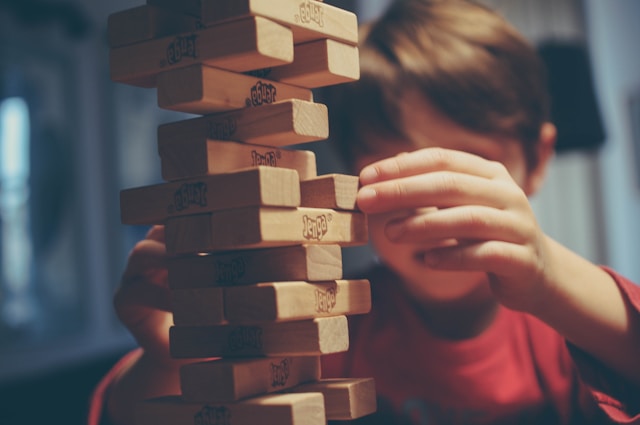
Becoming a strong family unit is challenging and things don’t always work out. However, there are numerous ways you can increase the odds of success.
The most popular strategy is to insist on family mealtimes. Bringing everyone together to eat is one of the best ways to ensure healthier relationships.
However, more parents are turning to games. Mothers and fathers are using competition and fun to get kids to interact with them more instead of focusing on their devices all the time.
In this post, we explore some of the family games that never get old. These are entertaining, fun to play, and can even help your children develop their intelligence.
UNO
Top of the list of family games that never get old is UNO. It’s fast-paced, fun, and relies on quick reactions.
The idea behind UNO is to get rid of all your cards as soon as you can while trying to stop your opponents from doing the same. The game is simple to play (making it suitable for kids aged 5 plus) but is also a great option for adults wanting to have some fun at the same time.
Plus, it’s cheap. All you need is essentially a pack of cards!
Pictionary
If your children are a bit more intellectual, you might want to try them on Pictionary. The purpose of the game is to guess what the other person on your team is drawing (ideal for parents versus kids battles!)
The makers of the game don’t make it straightforward. Many of the things the cards get you to draw are abstract or even catchphrases (instead of conventional physical objects you might find in the world). This aspect of the game makes it even more engaging, encouraging those drawing and guessing to be inventive and think out of the box.
Pictionary is the sort of game you can play for years without it ever getting old. There are hundreds of cards full of ideas.
Charades
If you don’t want to spend any money at all but still want to bring the family together, try charades. It’s more wide-ranging because of the ability to act out any word or phrase you want.
Charades doesn’t have much of a scoring system. But if you want to make it more competitive, write your own cards or download them off the internet and then distribute them randomly. This approach prevents one team from getting easy options, and the other one getting harder ones.
Cluedo
Those who love complex games full of intrigue and guile will love Cluedo. The idea is to guess who the murderer is by exploring a house (represented on a playing board) and looking for clues.
The funny thing about Cluedo is that it requires a combination of luck and skill. You can win the game outright via a process of elimination. But if you want to beat the other players, you can also guess the circumstances of the murder (including who did it, which room it happened in, and the object used).
The game can be a little macabre. But it isn’t all that complicated once you understand the basics. What’s more, it can be a fun way to tell a story and get kids interested in forensic investigations and detective work.
Connect 4
At the other end of the spectrum is Connect 4. This game is fun for families because it’s simple and you can play multiple rounds in a few minutes.
The idea is to create a string of four same-colored discs while preventing your opponent from doing the same. Usually, games involve one player nearly connecting four with the other blocking them. However, some games are more interesting, where both players have chances to win.
Usually, parents and kids split into two teams. However, you can arrange games however you want. For example, you might have two semi-finals and a final if you’re a family of four.
Twister
If you fancy something more physical, then Twister is a great game. It gets you to put your hands and feet in various circles on a plastic mat, forcing you to contort your body into all sorts of strange shapes.
The game is fun when played solo. But it is even better when you have multiple people.
If you can, leave one person out of the game to activate the spinner (the prop that tells players where to place their hands and feet). The winner is the last person standing.
Mahjong
If you want to play something brainier with your kids, then the Chinese game of mahjong is another excellent idea. Surprisingly, it is quite similar to poker. The idea is to shuffle cards, take turns, and make matching sets using various tiles on a board. The winning play shouts “mahjong” to end the game.
Mahjong is the type of game that becomes more interesting the more you play it. After a while, you begin to see deeper patterns, like chess, helping you play it better. It’s the sort of thing families can keep coming back to year after year once you understand the basic setup.
Monopoly
Monopoly is another classic game that teaches kids about the extraordinary power of capital and ownership. Each player starts with a moving piece and a pile of cash and must acquire properties as the game continues.
Matching a full set of properties of the same color grants the right to place houses and hotels. These increase the value of the “rent” the player can charge other players, ultimately aiming to bankrupt them.
As the game proceeds, more players get knocked out until there is eventually only one left holding the cash. Players can hold out for a little while by mortgaging their properties to pay their debts, but this strategy can only last so long. Eventually, the player with the highest-value rents will win.
Monopoly can take a long time to play, usually several hours. However, if you have a spare afternoon at the weekend, then playing it can be a lot of fun. Kids learn all sorts of tactics and the value of negotiation in financial settings.
Apples To Apples
Apples to Apples is a family-friendly version of Cards Against Humanity. The idea is to match nouns and adjectives to create funny phrases. The player with the funniest card combination wins.
Apples to Apples works best when you have three or four players and a judge. Players try to make their sentences funny while judges interpret their efforts to see who is the best.
While Apples to Apples might seem like a bit of fun, it is actually a great way to teach language skills. It may even help develop kids’ sense of humor!
Treasure Hunt
Kids love treasure hunts, and so do adults. Setting them up is often as much fun as hunting for hidden treats.
Treasure hunts work best if you have a garden and plenty of places to hide things out of the way. However, you can also use your home if you have plenty of nooks and crannies.
There are two types of treasure hunts you could organize. The first one, common around Easter time, is to hide mini chocolate eggs around the home and get kids to look for them on a timer. These games are quick to set up and you can do them any time.
The other type is more clues-based. Kids look for little bits of paper containing critical information about where they should go next. Eventually, they solve the riddle and find the big prize at the end, like a new bicycle or something similar.
Jenga
Jenga is another tried-and-tested game families love. And since the invention of the internet, it has also become a meme.
In Jenga, you and your kids have to remove blocks one by one from a precarious tower. Whenever the tower falls down after a player removes a brick, they are eliminated from the game.
Most families like to play 12 rounds. After each round, a player gets a point if they cause the tower to fall. At the end of the 12 rounds, the player with the lowest score wins.
Trivial Pursuit
Trivial Pursuit is another classic game that never seems to get old. The idea is to answer questions from various categories to earn wedges. The player who completes their piece first is the winner.
Of course, Trivial Pursuit requires quite a lot of knowledge to win, so it might not be suitable for younger children.
Wrapping Up
Games aren’t just things your family should do for fun. Instead, they’re essential for bringing everyone together and forging stronger bonds.
With today’s busy modern lives, it is more challenging than ever before for families to enjoy something collectively. However, games can bypass a lot of resistance and get people talking to each other again. It sounds simple, and it is!
Furthermore, real games have more beneficial effects than online equivalents. They foster a sense of responsibility and enable real-time person-to-person contact. Furthermore, many teach real skills, like strategy and navigating the environment, preparing children for the world’s challenges.
